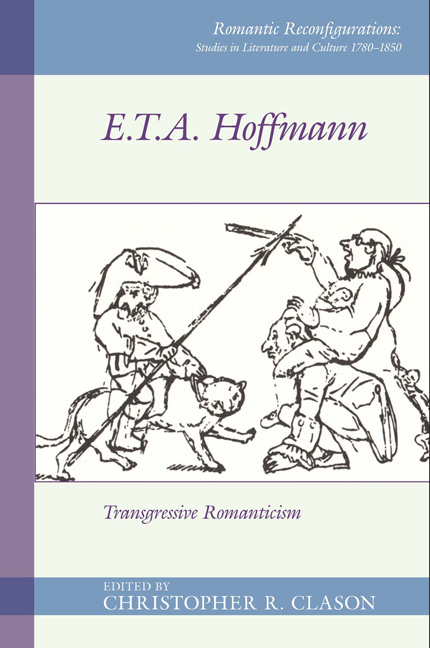Book contents
- Frontmatter
- Contents
- List of Figures
- Acknowledgements
- Notes on Contributors
- Introduction
- I Transgression and Institutions
- II Transgression and the Arts
- III Transgression in the Märchen
- 7 Transgressive Play and Uncanny Toys in E.T.A. Hoffmann's “Das fremde Kind”
- 8 Attending to the Everyday: Idiosyncrasy in E.T.A. Hoffmann's “Der goldene Topf”
- 9 Prinzessin Brambilla: The Aesthetic between Public and Private
- IV Transgression of Reception in Kater Murr
- Works Cited
- Index
9 - Prinzessin Brambilla: The Aesthetic between Public and Private
from III - Transgression in the Märchen
- Frontmatter
- Contents
- List of Figures
- Acknowledgements
- Notes on Contributors
- Introduction
- I Transgression and Institutions
- II Transgression and the Arts
- III Transgression in the Märchen
- 7 Transgressive Play and Uncanny Toys in E.T.A. Hoffmann's “Das fremde Kind”
- 8 Attending to the Everyday: Idiosyncrasy in E.T.A. Hoffmann's “Der goldene Topf”
- 9 Prinzessin Brambilla: The Aesthetic between Public and Private
- IV Transgression of Reception in Kater Murr
- Works Cited
- Index
Summary
Introduction
E.T.A. Hoffmann's story Prinzessin Brambilla (Princess Brambilla, 1820) has been read in many ways, for example, as a version of Schiller's aesthetic education (Slessarev); as a summary or satire of Fichte's or Schelling's idealism (Frischmann); as a handbook of sorts for Romantic irony (Strohschneider- Kohrs 155–60 and 362–424); or as a proto-modernist depiction of an initiation rite (Wellbery). Above all it is an apotheosis of the aesthetic on many levels. Not only does the work describe and evaluate a number of art objects of various forms as well as feature a variety of performances – architecture, cooking, costumes, dance, music, narration, a theatrical presentation, even a ‘flash mob’ as part of a Gesamtkunstwerk of sorts – it also claims to be derived from a series of sketches by the eighteenth-century French artist Jacques Callot. As an illustrated book, it exhibits these pictures as well as its own exhibition of them. It is also prominently a theater book, a book whose central character is an actor and whose fundamental plot achievement is a change in a city's aesthetic taste. These aesthetic events, like the carnival time which forms the setting of the story, transgress and overflow conventional distinctions, at times confusing and at times mediating between a variety of different categories: not only artistic media (as in the interplay between the text and the images), but also between nations (a German book about Rome, with a chorus of expat German artists), between reality and the virtual, between art and nature, existentially, between life and death, and, most importantly for my purposes here, between the private and the public. The narrative is divided between the thoughts and, at times, delusions of the main characters and their publicly visible actions, and much emphasis is placed on the relationship between the two, which serves to define and defend the rights of art and the imagination in public space. Prinzessin Brambilla, among its other achievements, is a key text in the history of aesthetic subjectivity in a mass society.
Any attempt at an overview of this “Capriccio after Jacques Callot” (119) must necessarily oversimplify, but this most complicated and confusing story in eight chapters is fundamentally structured as a romantic comedy, though with two additional layers of narrative.
- Type
- Chapter
- Information
- E. T. A. HoffmannTransgressive Romanticism, pp. 169 - 188Publisher: Liverpool University PressPrint publication year: 2018



